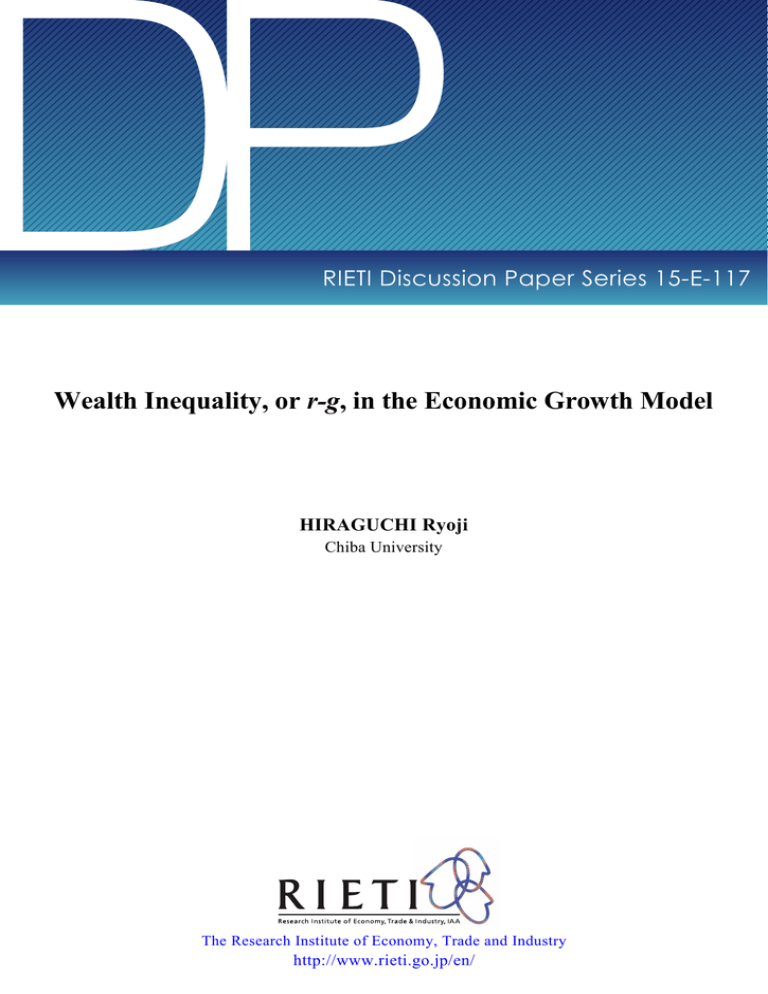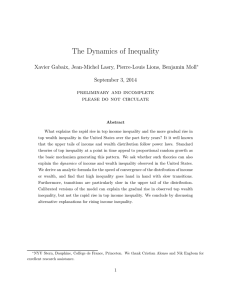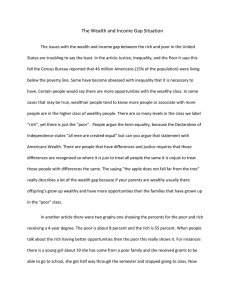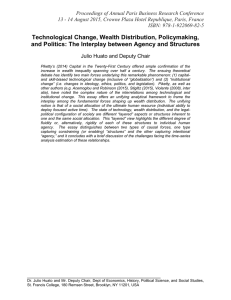DP r-g RIETI Discussion Paper Series 15-E-117 HIRAGUCHI Ryoji
advertisement

DP
RIETI Discussion Paper Series 15-E-117
Wealth Inequality, or r-g, in the Economic Growth Model
HIRAGUCHI Ryoji
Chiba University
The Research Institute of Economy, Trade and Industry
http://www.rieti.go.jp/en/
RIETI Discussion Paper Series 15-E-117
October 2015
Wealth Inequality, or r-g, in the Economic Growth Model 1
HIRAGUCHI Ryoji
Faculty of Law and Economics, Chiba University 2
Abstract
We investigate a simple continuous-time overlapping generations model with a
neoclassical production function and technological progress. We demonstrate that the
degree of wealth inequality is positively related to the difference between the real interest
rate r and the growth rate of income per capita g, and if g falls, the r-g gap widens and
inequality worsens. We also argue that a wealth tax reduces the wealth inequality. All of
these results are consistent with the famous predictions advanced by Thomas Piketty in
Capital in the Twenty-First Century (2014). We next investigate consumption tax and find
that it enhances capital accumulation and reduces r-g, and thus wealth inequality.
Keywords: Overlapping generations, Inequality, Pareto distribution, Wealth tax
JEL classification: E5
RIETI Discussion Papers Series aims at widely disseminating research results in the form of
professional papers, thereby stimulating lively discussion. The views expressed in the papers are solely
those of the author(s), and neither represent those of the organization to which the author(s) belong(s)
nor the Research Institute of Economy, Trade and Industry.
1
This study is conducted as a part of the Project "Sustainable Growth and Macroeconomic Policy"
undertaken at Research Institute of Economy, Trade and Industry (RIETI). The author is grateful for
helpful comments and suggestions by Masahisa Fujita, Masayuki Morikawa and Discussion Paper
seminar participants at RIETI.
2 Faculty of Law and Economics, Chiba University. 1-33, Yayoi-cho, Inage-ku, Chiba, Japan.
Email:ryojih@chiba-u.jp. Tel: 81-43-290-2399
1
Introduction
In his influential book Capital in the Twenty-First Century, Thomas Piketty predicts that
the gap between the rate of return on capital r and the per capita income growth rate g,
crucially affects the distribution of wealth. The gap r − g represents the degree of capital
income deviation from labor income (if it is not consumed). He argues that if r exceeds g,
inherited wealth will grow faster than labor income and consequently wealth distribution
will become highly concentrated. He also argues that if g is low, the gap r − g widens
and the wealth inequality worsens. In terms of economic policy, Piketty recommends a
wealth tax to reduce wealth inequality. His claims are validated through the theory by
Piketty and Zucman (2015); they construct a two-period overlapping generations (OLG)
model in which the individuals are heterogeneous in their preferences toward wealth. They
demonstrate that in a steady state wealth inequality is an increasing function of the term
1+r
.
1+g
Recently, however, some authors have criticized Piketty’s claims by using popular
economic growth models that are extensively studied in macroeconomics. Krusell and
Smith (2014) use the representative agent Ramsey model and show that if the period
utility function is logarithmic, then r − g equals the discount factor and then it does not
rise when the economic growth rate slows down. Mankiw (2015) obtains a similar formula
in a neoclassical growth model with capitalists and workers.
To our knowledge, Jones (2015) is the first to study a dynamic general equilibrium
model with heterogeneous agents and to doubt the importance of r − g or a wealth tax in
wealth inequality. He constructs a continuous-time OLG model with an AK production
function, the details of which are in Jones (2014). The stationary wealth distribution
is Pareto in his model. Jones represents the wealth inequality measure as a function of
the population growth rate, r − g and the wealth tax rate. However, he finds that in
the general equilibrium where the interest rate is determined endogenously, the inequality
measure depends only on the population growth rate. Thus, the gap r − g and wealth
tax are independent of the wealth inequality. Moll (2014) considers a similar model with
capitalists and workers and obtains the same conclusions.
2
In this paper we argue that the conclusions of Jones and Moll are not robust by using
a continuous time OLG model with a neoclassical production function. The set-up is very
close to the models advanced by Jones (2015) as well as Blanchard (1985). Our model
only differs from Jones in the curvature of the production function. We first obtain the
wealth distribution which is the generalized Pareto distribution. Then, we show that the
degree of wealth inequality is positively related to r − g, and, if the per capita income
growth rate g slows down, the gap widens and the inequality worsens. Finally, we show
that a wealth tax is useful in reducing wealth inequality. Therefore, our results support
Piketty’s claims.
Although the conclusions mentioned above are similar to those of Piketty and Zucman
(2015), our model crucially differs from theirs on the source of agent heterogeneity. Piketty
and Zucman (2015) assume that individuals differ in their preferences toward wealth
inheritance, whereas in our model, individuals differ only in their life spans. We show
that r − g affects wealth inequality in the popular Blanchard-type OLG models that
are found in many macroeconomics textbooks including Barro and Sala-i-Martin (2004),
Bertola et al. (2005), and Acemoglu (2009).
In terms of economic policy, Jones (2015) only examines wealth tax. Here we compare
consumption tax with wealth tax in terms of steady state wealth inequality. We show that
consumption tax reduce r̄ − g and also wealth inequality, but the mechanism is different.
Wealth tax reduces the net of tax rate of return on capital r̄ and lowers wealth inequality.
It decreases the steady state level of capital and raises the interest rate. On the other
hand, consumption tax enhances capital accumulation and reduces the rate of return on
capital. Therefore, consumption tax can reduce wealth inequality without reducing the
steady state output, while wealth tax reduces both inequality and output.
This paper is related to some recent literature on wealth inequality in dynamic general equilibrium models. Benhabib et al. (2011) explicitly characterize wealth distribution
in an OLG model in which the agents receive idiosyncratic shocks on their investment
and age. Nirei and Aoki (2015) investigate a neoclassical growth model in which individuals are subject to idiosyncratic investment shocks and borrowing constraints, and
3
demonstrate that wealth is distributed according to Pareto. However, they do not study
the relationship between r − g and inequality. Moreover, Nirei and Aoki (2015) argue
that, wealth distribution becomes flatter when the economic growth rate is low, and their
conclusion is contrary to Piketty’s prediction.
This paper is organized as follows. Section 2 describes the basic structure of the model.
Section 3 investigates how the degree of inequality is related to r − g. Section 4 compares
consumption tax with wealth tax. Section 4 concludes the paper.
2
The Model
In this section, we provide an overview of our model.
2.1
Preferences
Time is continuous. In each period, a continuum of individuals is born. The number of
newborns at date t is Bt = B0 ent , where n > 0 and B0 > 0. Death follows the Poisson
process with an arrival rate d. The population of agents born on date s (henceforth cohort
s) is Lt,s = de−d(t−s) Bs in period t. In accordance with Jones (2014), the total population
∫t
Lt = −∞ Lt,s ds evolves according to
L̇t = Bt − dLt ,
and in steady state,
L̇t
Lt
= n and Lt =
Bt
.
n+d
An agent supplies one unit of labor in the labor market and receives wage income in
each period. Cohort s maximizes the following expected intertemporal utility:
∫ ∞
U=
e−(ρ+d)(t−s) ln Ct,s dt,
s
subject to the following budget constraint
Żt,s = (rt − τ )Zt,s + Wt − Ct,s ,
(1)
where ρ is the discount factor, Ct,s is the consumption level of cohort s in period t, Zt,s is
the asset holdings of cohort s in period t, rt is the real interest rate in period t, τ is the
4
linear capital income tax, and Wt is the wage income in period t. Here, we follow Jones
∫t
(2015) and assume that the tax revenue is discarded. We let Zt = −∞ Lt,s Zt,s ds denote
the total wealth at time t. Individuals equally inherit the assets of the agents who die.
Then, the initial asset level of cohort s is Zs,s =
dZs
Bs
= θ LZss with θ =
d
.
n+d
Following Piketty and Zucman (2015), we let r̄t = rt − τ denote the rate of return
∫∞
(net-of-tax) on capital. The human wealth is defined as Ht = t e−R̄x,t Wx dx, where
∫x
R̄x,t = t r̄z dz is the compound interest rate (net-of-tax). It evolves according to
Ḣt = r̄t Ht − Wt .
As the utility function is logarithmic, the consumption of cohort s at time t is given by
Ct,s = (ρ + d)(Zt,s + Ht ).
(2)
In the competitive equilibrium, total wealth is equal to total capital, which means that
∫t
Zt = Kt . Therefore, the aggregate consumption at time t, Ct = −∞ Lt,s Ct,s ds is
∫ t
Ct = (ρ + d)
Lt,s (Zt,s + Ht )ds = (ρ + d)(Kt + Lt Ht ).
(3)
−∞
2.2
Production
There are many identical firms. The production function F has constant returns to scale
and is given by F (Kt , At Lt ), where Kt is the capital, At is the technology level, and Lt is
the labor supply. The growth rate of At ,
Ȧt
At
is exogenous and equals g. We let kt =
Kt
At Lt
denote the capital per efficiency unit of labor at time t. The production function per
efficiency unit of labor f (k) = F (k, 1) satisfies f (0) = 0, f ′ > 0, f ′′ < 0 and f ′ (0) = +∞.
Factor markets are perfectly competitive, and the equilibrium wage rate in period t is
Wt = At {f (kt ) − kt f ′ (kt )} and the capital rental rate in period t is rt = f ′ (kt ). As the
total tax revenue τ Kt is thrown away, the resource constraint is
K̇t = F (Kt , At Lt ) − Ct − τ Kt .
(4)
k̇t = f (kt ) − ct − (gt + nt + τ )kt ,
(5)
Eq. (4) is re-expressed as
5
where ct =
Ct
At Lt
Let ht =
Ht
At
denotes the consumption per efficiency unit of labor.
and wt =
Wt
.
At
From Eq. (3), we have ct = (ρ + d)(kt + ht ). As ht evolves
according to ḣt = (r̄t − g)ht − wt , we have
ċt = (r̄t − g − ρ − d)ct − (ρ + d)nkt .
(6)
The path of (ct , kt ) is determined by Eqs. (5) and (6).
2.3
Balanced growth path
We now focus on the balanced growth path (BGP), where ct = c, kt = k, wt = w, and
rt = r are all constant, and the growth rate of output per capita, At f (kt ) is g. Eqs. (5)
and (6) imply that the stationary allocation (c, k) is determined by
n(ρ + d)k
,
r̄ − g − ρ − d
c = f (k) − (g + τ + n)k,
c =
(7)
(8)
where r̄ = f ′ (k) − τ . When n and d are zero, our model coincides with the Ramsey model,
and the steady state interest rate is r̄ = ρ + g. Thus, r̄ − g coincides with the discount
factor, as Krusell and Smith (2014) have pointed out.
3
Wealth inequality and r − g
This section follows Jones (2015) and obtains the wealth distribution along the BGP.
3.1
The gap r − g in the steady state
We first characterize r̄ − g. Here we focus on the Cobb-Douglas production function
f (k) = k α , where α ∈ (0, 1). In this case, r = αk α−1 . We let c1 (k) and c2 (k) denote the
right-hand side of Eqs. (7) and (8), respectively. The two functions are expressed as
k
,
αk α−1 − g − τ − ρ − d
c2 (k) = k α − (g + τ + n)k.
c1 (k) = n(ρ + d)
6
(9)
(10)
Figure 1: Stationary allocation
The function c1 (k) is increasing, convex, and satisfies c1 (0) = 0 and limk→km c1 (k) = +∞
α
)1/(1−α) . Similarly, the function c2 (k) is concave and satisfies c2 (0) = 0
with k m = ( g+ρ+τ
and c′2 (0) = +∞. As Figure 1 shows, the curves c = c1 (k) and c = c2 (k) have a unique
intersection. We have the following proposition on r̄ − g.
Proposition 1 Along the BGP, r̄ − g solves the following quadratic equation on x:
{x + (1 − α)(g + τ ) − αn}(x − ρ − d) = αn(ρ + d).
(11)
The gap r − g is a strictly decreasing function of g and τ .
Proof. See the Appendix.
Proposition 1 shows that when the economic growth rate slows down, the gap r − g
rate widens. This is consistent with Piketty’s prediction.
3.2
Wealth distribution and r − g
From Eqs. (1) and (2), the assets of cohort s evolve according to
Żt,s = (r̄t − ρ − d)Zt,s + Wt − (ρ + d)Ht .
If we let zt,s = Zt,s /At , then zs,s = θks and
żt,s = (r̄ − g − ρ − d)zt,s + wt − (ρ + d)ht .
7
Inequality
0.25
0.2
0.15
0.1
0.05
0
0
2
4
6
8
10
Economic growth rate g (%)
Figure 2: Inequality and growth
Along the BGP, where k, w, and h are constant and (r̄ − g)h = w, we have
zt,s = e(r̄−g−ρ−d)(t−s) (h + θk) − h.
At time t, the relative population of cohort s is
(
Pr(Zt,s ≥ x) =
Lt,s
Lt
h + x/At
h + θk
= (d + n)e−(d+n)(t−s) . Therefore
d+n
)− r̄−g−ρ−d
.
(12)
The individual wealth is distributed according to the generalized Pareto distribution, and
the Pareto inequality measure η which is the inverse of the exponent in Eq. (12) is
η=
r̄ − g − ρ − d
.
d+n
(13)
If r̄ − g widens, so inequality definitely worsens. As shown in Proposition 1, the reduction
of g increases r̄ − g, and subsequently raises η. Similarly, the increase of τ reduces the
gap, which in turn reduces η. Thus, we have the following proposition.
Proposition 2 A slowdown in the per capita income growth rate raises the inequality
measure η, and wealth tax reduces η.
Figure 2 shows a negative relationship between the wealth inequality and g when
α = 1/3, ρ = 0.05, n = 0.01 and d = 0.05. The parameters for α, ρ, and d are from
8
Mankiw and Weinzierl (2006). As the economic growth rate declines from 10% to zero,
the Pareto inequality measure almost doubles from 0.12 to 0.22.
Our result differs from Jones (2015) who demonstrated that the inequality index is
independent of r −g and τ . The production function he uses is an AK type, with the wage
income and human wealth both equal to zero. In this case, Eq. (3) becomes C = (ρ+d)K,
and Eq. (4) is expressed as K̇ = (A − ρ − d − τ )K. Thus the per capita income growth
rate is A − ρ − d − τ − n ≡ ĝ. The interest rate is r = A, and the inequality measure is
η=
r̄−ĝ−ρ−d
d+n
=
n
,
d+n
which is unrelated to r − g and τ . As this paper illustrates, Jones’
conclusion crucially depends on the linearity of the production function.
4
Robustness
In this section, we show that our result on the relevance of r − g and τ on inequality
continues to hold in a three cases: 1) the individuals buy annuities; and 2) the tax
revenue is rebated lump-sum.
4.1
Use of annuities
In the previous section, we assumed that the wealth of the people who die is re-distributed
to the newborns. Here we consider a model where the individuals purchases annuities as
in Blanchard (1985). Annuity markets are competitive and the insurance company pays
to the individual with financial wealth Z by dZ units. The agent born at date s is now
subject to
Żt,s = (r̄ + d)Zt,s + Wt − Ct,s .
The initial asset level Zs,s is zero. Here the rate of return on asset is r̄ + d, while in the
original model it is r̄. The individual consumption function is the same as before, but the
human wealth now evolves according to Ḣt = (r̄ + d)Ht − Wt or equivalently
ḣ = (r + d − g)h − w.
9
The resource constraint is the same as before, and thus ċ = (r̄ − g − ρ)c − (ρ + d)(d + n)k.
The steady state allocation (c, k) are determined by
k
,
r̄ − g − ρ
c = f (k) − (g + n + τ )k.
c = (n + d)(ρ + d)
If we let zt,s = Zt,s /A, it evolves according to
żt,s = (r − g − ρ − τ )zt,s + w − (ρ + d)h.
Along the BGP, zt,s = (e(r−g−ρ−τ )(t−s) − 1)h. Then
d
(
x )− r̄−g−ρ
Pr(Zt,s ≥ x) = 1 + gt
he
and the Pareto inequality measure is η̂ =
r̄−g−ρ
,
d
which is very close to the previous one.
We have the following proposition.
Proposition 3 The slowdown in the economic growth rate worsens wealth inequality
when the individuals buy annuities.
Proof. See the Appendix.
4.2
Lump-sum transfer
So far we have assumed that the wealth tax is thrown away. In this section, we consider a
case where the tax revenue is rebated via lump-sum. The agent born at date s maximizes
∫∞
the utility 0 e−(ρ+d)(t−s) ln Ct,s dt subject to
Żt,s = (r − τ )Zt,s + St + Wt − Ct,s .
where St is the lump-sum government subsidy. In the competitive equilibrium, the govenment budget constraint is
St Lt = τ Kt .
Here the human wealth includes the lump-sum transfer Ht∗ =
It evolves according to
Ḣt∗ = (r − τ )Ht∗ − Wt − τ
10
Kt
.
Lt
∫∞
t
e−Rx (x−t) (Wx + Sx )dx.
The consumption function is given by Ct,s = (ρ + d)(Zt,s + Ht∗ ). Therefore the aggregate
consumption function is Ct = (ρ + d)(Zt + Lt Ht∗ ). If we let h∗t = Ht∗ /At , it satisfies
ḣ∗t = (r − τ − g)h∗t − wt − τ kt .
The tax revenue is no longer thrown away and then the resource constraint implies k̇ =
f (k) − c − (g + n)k. One can easily check that the technology-adjusted consumption
function c = (ρ + d)(k + h∗ ) evolves according to (6). Along the BGP, the stationary
allocation (c, k) is determined by (7) and
c = f (k) − (g + n)k.
The only difference is that the second equation does not include τ . Thus we have the
following proposition.
Proposition 4 Capital income tax reduces inequality even when the tax is revenue is
rebated lump-sum.
Proof. See the Appendix.
5
Use of consumption tax
So far we have investigated only wealth tax. In this section, we consider a linear consumption tax and check how it affects wealth inequality. Cohort s maximizes the following
expected intertemporal utility U subject to the following budget constraint
Żt,s = rt Zt,s + Wt − (1 + τ )Ct,s + St .
(14)
Here τ is a linear consumption tax, and St is the lump-sum government subsidy. In the
competitive equilibrium, the budget constraints are written as
St Lt = τ Ct .
As the utility function is logarithmic, the consumption of cohort s at time t is given by
(1 + τ )Ct,s = (ρ + d)(Zt,s + Ht ),
11
(15)
Figure 3: consumption tax and inequality
where the human wealth evolves according to Ḣt = rt Ht −(Wt +St ). With simple algebra,
we get
1
n(ρ + d)k
,
1+τ r−g−ρ−d
c = f (k) − (g + n)k,
c =
(16)
(17)
As is clear from Figure 3, consumption tax shifts ċ = 0 curve to the right and consequently
the equilibrium level of steady state capital increases. Therefore the rate of return on
capital r(k) and also the gap r(k) − g declines. Thus we have the following proposition.
Proposition 5 Consumption tax reduces wealth inequality.
Although both wealth tax and consumption tax reduce r̄ − g and also wealth inequality, the mechanism is different. Wealth tax reduces the net of tax rate of return on capital
r̄ and lowers wealth inequality. It then decreases the steady state level of capital. On the
other hand, consumption tax discourages consumption and enhances saving. Thus it accumulates more capital and reduces the rate of return on capital. Therefore, consumption
tax can reduce wealth inequality without reducing the steady state output, while wealth
tax reduces both inequality and output.
12
6
Conclusion
In this paper, we investigate a continuous-time OLG model with capital accumulation
in which agents are subject to the constant death probability, and demonstrate that the
gap r − g and wealth tax are closely related to wealth inequality. All of these results
are consistent with the famous predictions advanced by Thomas Piketty in Capital in the
Twenty-First Century (2014). In terms of economic policy, we find that consumption tax
is better than wealth tax in terms of reducing inequality, because consumption tax does
not reduce the steady state capital and also consumption. As a future study, we would
like to incorporate heterogeneity in human capital accumulation.
13
Appendix
The Appendix provides proofs for propositions.
A
Proof of Proposition 1
As f (k)/k = k α−1 = r/α, Eqs. (9) and (10) imply that if c1 (k) = c2 (k), then
(r/α − g − τ − n)(r̄ − g − ρ) = nd(ρ + d).
Therefore, r̄ − g solves Eq. (11). In Eq. (11), if g and x(= r̄ − g) simultaneously increase,
the left-hand side increases, while the right hand side is constant. This is impossible, and
therefore,
B
d(r̄−g)
dg
< 0. We can argue the same point on τ . ¥
Proof of Proposition 3
The steady state capital per efficiency unit of labor satisfies
f (k) − (g + n + τ )k = (n + d)(ρ + d)
k
.
r̄ − g − ρ
As f (k)/k = r/α, the gap x = r̄ − g solves the following quadratic equation:
{x + (1 − α)(g + τ ) − αn}(x − ρ) = α(n + d)(ρ + d).
(18)
The left hand side is an increasing function of g and x while is the right hand side is
independent of g and x. Thus dx/dg < 0. The inequality measure η̂ = (x − ρ)/d is an
increasing function of x and then dη̂/dg < 0. ¥
C
Proof of Proposition 4
The net-of-tax rate of returns on capital r̄ solves
(r̄ + (1 − α)τ − αg)(r̄ + τ − ρ − g) = αd(ρ + d).
The left hand side is an increasing function of r̄ and τ , while the right hand side is
independent of r̄ and τ . Thus dr̄/dτ < 0 and then dη̂/dτ < 0. ¥
14
References
[1] Acemoglu, D. (2009), Introduction to Modern Economic Growth, Princeton University Press, Princeton, NJ.
[2] Barro, R. and X. Sala-i-Martin (2004), Economic Growth, The MIT Press, Cambridge, MA.
[3] Benhabib, J., A. Bisin, and S. Zhu (2014), The Distribution of Wealth in the
Blanchard-Yaari Model, Macroeconomic Dynamics, forthcoming.
[4] Bertola, G., R. Foellmi, and J. Zweimuler (2005), Income Distribution in Macroeconomic Models. Princeton University Press, Princeton, NJ.
[5] Blanchard, O. (1985), Debt, Deficits and Finite Horizons, Journal of Political Economy, 93, 223–47.
[6] Jones, C. (2014), Simple Models of Income and Wealth inequality, mimeo.
[7] Jones, C. (2015), Pareto and Piketty: The Macroeconomics of Top Income and
Wealth Inequality, Journal of Economic Perspectives, 29, 29–46.
[8] Krusell, P. and A. Smith (2014), Is Piketty’s ‘Second Law of Capitalism’ fundamental? National Bureau of Economic Research.
[9] Mankiw, G. and M. Weinzierl (2006), Dynamic Scoring: a Back-of-the-Envelope
Guide, Journal of Public Economics, 90, 1415–1433.
[10] Mankiw, G. (2015), Yes, r > g. So What? American Economic Review, 105, 43-47.
[11] Moll, B. (2014), Lecture 6: Income and Wealth Distribution, mimeo.
[12] Nirei, M., and S. Aoki (2015), Pareto Distribution of Income in Neoclassical Growth
Models, mimeo.
[13] Piketty, T. (2014), Capital in the Twenty-First Century, translated by Arthur Goldhammer, Belknap Press.
15
[14] Piketty, T. and G. Zucman (2015), Wealth and Inheritance in the Long Run, Handbook of Income Distribution, Volume 2, edited by A. Atkinson and E. Bourguignon,
1303-68. North Holland.
[15] Yaari, M.E. (1965), Uncertain Lifetime, Life Insurance, and the Theory of the Consumer, The Review of Economic Studies 32(2): 137-50.
16








